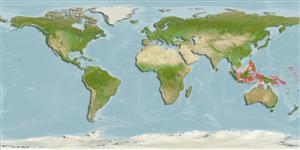Environment: milieu / climate zone / depth range / distribution range
Ecologia
marino; salmastro demersale; distribuzione batimetrica 0 - 10 m (Ref. 90102). Tropical; 19°N - 12°S
Western Pacific: Indonesia, New Guinea, the Solomons, the Philippines and Taiwan. Reported from Palau (Ref. 2847).
Size / Peso / Age
Maturity: Lm ? range ? - ? cm
Max length : 14.0 cm SL maschio/sesso non determinato; (Ref. 48635)
Short description
Morfologia | Morfometria
Spine dorsali (totale): 3; Raggi dorsali molli (totale): 12; Raggi anali molli: 6 - 7. Usually features one or two ocelli on the soft dorsal fin. Length to 14 cm (Ref. 48635).
Unusual among antennariids in often occupying brackish or even totally freshwater habitats. Most specimens were taken at 10 m depth or less. Oviparous. Eggs are bound in ribbon-like sheath or mass of gelatinous mucus called 'egg raft' or 'veil' (Ref. 6773).
Life cycle and mating behavior
Maturità | Riproduzione | Deposizione | Uova | Fecundity | Larve
Oviparous. Eggs are bound in ribbon-like sheath or mass of gelatinous mucus called 'egg raft' or 'veil' (Ref. 6773).
Pietsch, T.W. and D.B. Grobecker, 1987. Frogfishes of the world. Systematics, zoogeography, and behavioral ecology. Stanford University Press, Stanford, California. 420 p. (Ref. 6773)
IUCN Red List Status (Ref. 130435)
Threat to humans
Poisonous to eat
Human uses
Pesca: di nessun interesse
Informazioni ulteriori
BibliografiaAcquacolturaProfilo di acquacolturaVarietàGeneticaElectrophoresesEreditarietàMalattieElaborazioneNutrientsMass conversion
CollaboratoriImmaginiStamps, Coins Misc.SuoniCiguateraVelocitàModalità di nuotoArea branchialeOtolithsCervelliVista
Strumenti
Special reports
Download XML
Fonti Internet
Estimates based on models
Preferred temperature (Ref.
123201): 28 - 29.3, mean 28.8 °C (based on 827 cells).
Phylogenetic diversity index (Ref.
82804): PD
50 = 0.5005 [Uniqueness, from 0.5 = low to 2.0 = high].
Bayesian length-weight: a=0.01995 (0.00906 - 0.04395), b=3.01 (2.83 - 3.19), in cm total length, based on all LWR estimates for this body shape (Ref.
93245).
Trophic level (Ref.
69278): 4.1 ±0.7 se; based on size and trophs of closest relatives
Resilienza (Ref.
120179): Alto, tempo minimo di raddoppiamento della popolazione meno di 15 mesi (Fec assumed to be > 10,000).
Fishing Vulnerability (Ref.
59153): Low vulnerability (10 of 100).
